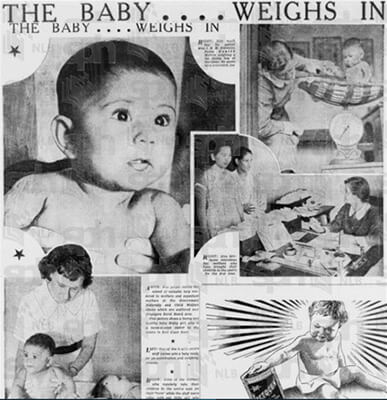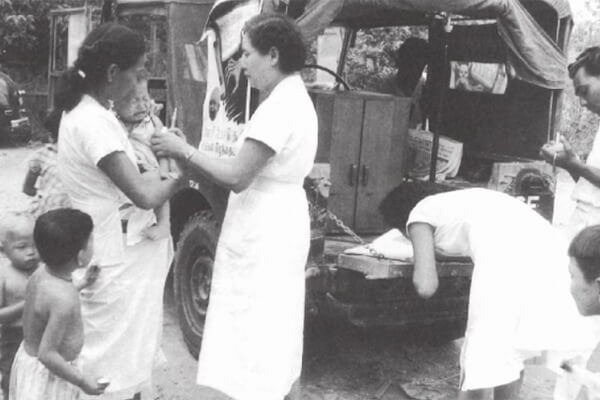
BORN
1882
DIED
1958
INDUCTED
2021
CATEGORY
Health

THE HONOURED INDUCTEES TO THE SINGAPORE WOMEN’S HALL OF FAME
IDA MABEL MURRAY SIMMONS
Ida Simmons was a public health nurse who transformed infant and maternal health care in Singapore. When she started working in Singapore in 1927, the infant mortality rate was 263 deaths per 1,000 babies. When she retired 21 years later, the rate was down to 57 deaths per 1,000 babies. The enormous improvement was largely due to Ida’s pioneering work in building a rural healthcare service.
Ida’s nursing career began during the 1st World War when she joined the Volunteer Aid Detachment (VAD). She served with distinction at military hospitals in England and France between 1916 and 1919.
She then trained at the Royal Edinburgh Infirmary. After receiving her certification in 1922, Ida won the only British scholarship for a one-year International Red Cross public health course in London. After this she returned to the Royal Edinburgh Infirmary where she was a sister tutor until 1926.
In December 1926 Ida joined the Straits Settlements Medical Department and came out to Singapore. In January 1927 she started her job, which was to introduce infant and maternal health services in rural Singapore, an area that at that time covered some 200 square miles or almost half the island.
The rural population then comprised about 100,000 people, many of whom were Malay villagers but there were also, Ida noted in a talk she gave in the late 1940, Tamils, Sikhs, Chinese, Arabs, Eurasians, and some Japanese.
Ida spent the first few months learning Malay, and then she set out to visit every village. It was hot and hard work as there were not many roads in the rural areas and some villages did not have names. For many of the villagers, medical care was provided by traditional healers and they were wary of Western medicine.
Over the next two years and eight months, Ida travelled 43,000 miles in and about Singapore. Every district was visited either weekly or fortnightly by Ida and her team. A key aim was to monitor the health of babies in their first year after birth and to educate the mothers.
The team collected birth reports from the rural police stations and then tried to find and examine the infants. They were not always able to locate the babies whose births had been reported, and sometimes they came across infants whose births had not been reported.
The Health Department’s mobile dispensary, which had a doctor and a dresser who spoke several languages, would park along the road while Ida and her team trekked into the villages. When they found someone needing medical attention, they either told them to go to the mobile dispensary or they would summon the doctor.
Ida realised, however, that more was needed than the mobile dispensary. In her 1940 talk she said that more effective educational work could be done at rural welfare centres where ‘the mothers could meet one another, compare the babies and have a gossip’.
The first of these centres was set up in 1930, and more soon followed. Ida supervised the recruitment and training of new nurses and midwives for the centres.
At the centres, Ida explained, ‘all elaborate equipment is avoided, we aim at efficiency with economy. Demonstrations are given as far as possible with articles the mothers can use in their own homes. Diets the mothers cannot afford are never advised, but they are encouraged to make the best use of the resources of their own kampongs’.
In 1934, Ida was promoted to Public Health Matron for rural Singapore and in 1940, Simmons was made a Member of the Order of the British Empire in recognition of her work.
Ida was interned during the 2nd World War at Changi Prison and the Sime Road camp. She kept herself busy during internment by, amongst other things, sewing 3,000 pairs of pants for the male internees.
After the war, Ida began rebuilding the rural health services, which had been neglected under the Japanese. By the time she retired and returned to Britain in 1948, there were 15 full-time rural maternity and child health centres and 11 more that opened fortnightly, a large and efficient team of local rural nursing staff, a sharply lower infant mortality rate, and a very much healthier rural population.

IDA MABEL MURRAY SIMMONS
Pioneering public health nurse
BORN 1882 DIED 1958
INDUCTED 2021 CATEGORY Health
Ida Simmons was a public health nurse who transformed infant and maternal health care in Singapore. When she started working in Singapore in 1927, the infant mortality rate was 263 deaths per 1,000 babies. When she retired 21 years later, the rate was down to 57 deaths per 1,000 babies. The enormous improvement was largely due to Ida’s pioneering work in building a rural healthcare service.
Ida’s nursing career began during the 1st World War when she joined the Volunteer Aid Detachment (VAD). She served with distinction at military hospitals in England and France between 1916 and 1919.
She then trained at the Royal Edinburgh Infirmary. After receiving her certification in 1922, Ida won the only British scholarship for a one-year International Red Cross public health course in London. After this she returned to the Royal Edinburgh Infirmary where she was a sister tutor until 1926.
In December 1926 Ida joined the Straits Settlements Medical Department and came out to Singapore. In January 1927 she started her job, which was to introduce infant and maternal health services in rural Singapore, an area that at that time covered some 200 square miles or almost half the island.
The rural population then comprised about 100,000 people, many of whom were Malay villagers but there were also, Ida noted in a talk she gave in the late 1940, Tamils, Sikhs, Chinese, Arabs, Eurasians, and some Japanese.
Ida spent the first few months learning Malay, and then she set out to visit every village. It was hot and hard work as there were not many roads in the rural areas and some villages did not have names. For many of the villagers, medical care was provided by traditional healers and they were wary of Western medicine.
Over the next two years and eight months, Ida travelled 43,000 miles in and about Singapore. Every district was visited either weekly or fortnightly by Ida and her team. A key aim was to monitor the health of babies in their first year after birth and to educate the mothers.
The team collected birth reports from the rural police stations and then tried to find and examine the infants. They were not always able to locate the babies whose births had been reported, and sometimes they came across infants whose births had not been reported.
The Health Department’s mobile dispensary, which had a doctor and a dresser who spoke several languages, would park along the road while Ida and her team trekked into the villages. When they found someone needing medical attention, they either told them to go to the mobile dispensary or they would summon the doctor.
Ida realised, however, that more was needed than the mobile dispensary. In her 1940 talk she said that more effective educational work could be done at rural welfare centres where ‘the mothers could meet one another, compare the babies and have a gossip’.
The first of these centres was set up in 1930, and more soon followed. Ida supervised the recruitment and training of new nurses and midwives for the centres.
At the centres, Ida explained, ‘all elaborate equipment is avoided, we aim at efficiency with economy. Demonstrations are given as far as possible with articles the mothers can use in their own homes. Diets the mothers cannot afford are never advised, but they are encouraged to make the best use of the resources of their own kampongs’.
In 1934, Ida was promoted to Public Health Matron for rural Singapore and in 1940, Simmons was made a Member of the Order of the British Empire in recognition of her work.
Ida was interned during the 2nd World War at Changi Prison and the Sime Road camp. She kept herself busy during internment by, amongst other things, sewing 3,000 pairs of pants for the male internees.
After the war, Ida began rebuilding the rural health services, which had been neglected under the Japanese. By the time she retired and returned to Britain in 1948, there were 15 full-time rural maternity and child health centres and 11 more that opened fortnightly, a large and efficient team of local rural nursing staff, a sharply lower infant mortality rate, and a very much healthier rural population.

Photo Courtesy of Singapore Press Holdings
Sources:
- Scotlands People
- NURSES FOR BRUNEI – The Straits Times, 27 January 1950
- Singapore Health Pioneer Retires – The Straits Times, 2 June 1948
Profile photo courtesy of National Archive of Singapore
Profile last updated: 7th March 2022

